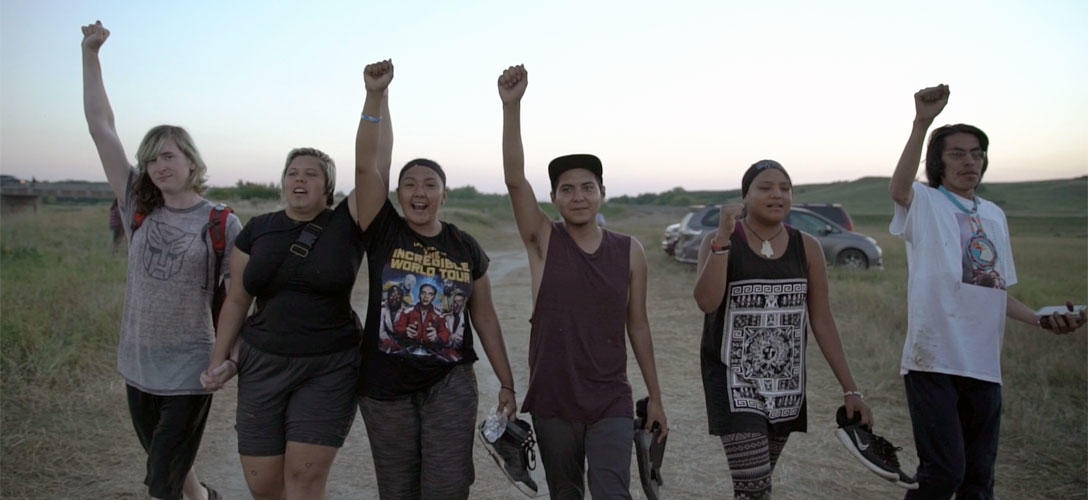Heather Rae, Ben Dupris, & Cody Lucich
Heather Rae, a Sundance-supported producer and the director of the 2005 Sundance Film Festival documentary selection “Trudell,” was recently on the ground with other Native filmmakers, Cody Lucich and Ben Dupris, at Standing Rock in North Dakota telling their story of the fight against the Dakota Access Pipeline. The following is an account of their time protecting Native lands.
Since April of this year, Native people from all over North America have been gathering on the Standing Rock reservation in North Dakota in support of the Standing Rock Sioux Tribe and their fight against a pipeline proposed to traverse treaty land and impede their water source, the Missouri River.
The U.S. Army Corps of Engineers approved the 1,100 mile long Dakota Access Pipeline without full, effective, and meaningful consultation with the tribe. In a global landscape of non-renewable energy projects, tribal and treaty-protected lands are often the targets of these projects, and despite the fact that more than 500 treaties were signed by the U.S. government, they’ve broken every single one.
In the case of Standing Rock, North Dakota, something happened: A whispering spirit guided the people to rise up and demand an end to toxic fossil fuel projects already polluting their prairie homeland. A commitment was prayed upon – to put their lives on the line.
It started with the Sacred Stone Camp, set up in April to monitor the pipeline activity. Dozens of Native youth organized a spiritual run for awareness of the issue and ran 500 miles to the Army Corps of Engineers headquarters in Omaha, Nebraska. They decided then to run nearly 2,000 miles to Washington, D.C. with a petition signed by more than 140,000 people.
In early August construction began on the pipeline despite the fact that permits had not been granted to dig under the river. The citizens of Standing Rock and their supporters physically blocked the construction with their bodies. The call for action went wide to all the Indigenous people of the world, to join together in solidarity to stop the Dakota Access Pipeline.
Since early August, when this small group of ‘Protectors’ stopped the construction of the pipeline, there have been thousands of Native people representing more than 200 tribes who have poured into the camp near Cannon Ball, North Dakota. They have gathered on the sacred land of the Oceti Sakowin, the Great Sioux Nation.
The traditional camp is peaceful place and dedicated to non-violent, direct action in the spirit of past great movements that honor the First Amendment of the United States Constitution. Marches, rallies, and traditional ceremonies have been consistent to the movement.
In a sea of tipis, tents, and tribal flags that blanket the landscape, an awakening of unity has been born. It is not something that most of us have experienced in our lifetime, but the story is unfolding as each day comes and history is being made. It is a cultural revival for people indigenous to the Americas.
“We are a spirit, we are a natural part of the earth, and all of our ancestors, all of our relations who have gone to the spirit world, they are here with us. That’s power.” — John Trudell

On September 9th, U.S. district court judge in DC, James Boasberg, ruled in favor of Dakota Access Pipeline and granted them the go-ahead to continue construction. Within minutes of the judge’s decision, the Department of Justice and the Department of the Interior, along with the Army Corps of Engineers in Washington, D.C. issued a statement requesting that construction within twenty miles of Lake Oahe be halted until further environmental assessments can be conducted. Standing Rock’s position all along, and the reason for the lawsuit filed by the tribe in July, was simply to force Dakota Access and the Army Corps to comply with federal law.
“The case has highlighted the need for a serious discussion on whether there should be nationwide reform with respect to considering tribes’ views on these types of infrastructure projects,” the D.O.J. stated.
The Department of Justice simply called for more time to consider what is next, a move which for some is a dangerous softening to this perceived victory. We can trace economic and political systems as we know them back to British and Spanish imperialism, and these structures have never been favorable to Indigenous philosophies. Throughout the world, energy companies have literally and figuratively bulldozed their way through the land and rights of Indigenous people. It is a devastating cycle for which the world just got the bill: climate change.
Standing Rock symbolizes a shift in this reality. It has become an international stage for the recurring environmental standoff plaguing the world today. The humble beginnings of a women’s prayer circle have become the extraordinary movement of a lifetime, the battle for mother earth, and her first medicine, our water.
“Water is the first food that a mother feeds her unborn child, while still in the womb. This is why women are leading this war.” — Ladonna Bravebull Allard
For those of us who are media makers, filmmakers, storytellers — and have been a part of the Standing Rock camp — we can only hope that our medium contributes to the countenance of these events.
In the oral tradition — the way history travels for ancient cultures — the story is created and passed along so that knowledge may prevail and feed the people. As media makers, we may be a part of this tradition, simply employing a new form. We realize that the story documented becomes a part of the tradition of story carrying and speaks to generations 100 years from now and beyond. We do this for our ancestors, and our grandchildren. This is how it has always been, regardless of what we endure as a people.
“We have power… Our power isn’t in a political system, or a religious system, or in an economic system, or in a military system; those are authoritarian systems… they have power, but it’s not reality. The power of our intelligence, individually or collectively, is the power. This is the power that any industrial ruling class truly fears: Clear coherent human beings.” — John Trudell




